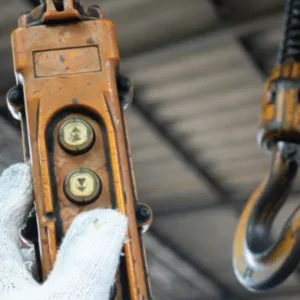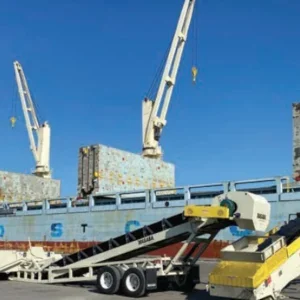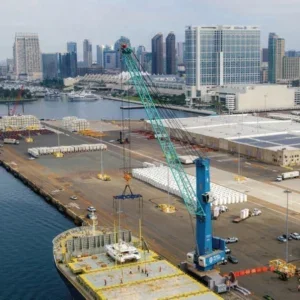The results of the existing crane runway and mill building upgrade analyses to a great extent depend on the following:
– How accurately the crane loads, especially dynamic loads, are evaluated
– How accurately the crane runway support system (crane girders, building framing and foundations) is presented in the structural model used in the analysis
– How accurately the remaining fatigue life of the crane runway fatigue sensitive components is evaluated
Excessively conservative design criteria accepted in the upgrade project analyses might show that the crane runway and building should be reinforced. This crane runway and building reinforcement usually associates with a long downtime period for mill operation and large capital expenses. This conclusion could make the mill upgrade project economically unfeasible.
The following equation defines the theoretical relationship between the required strength and the allowable strength in terms of the allowable stress design (ASD) method:
Ra = Rn / F.S.
The left side of the equation is the required strength (design forces or moments) which is a function of loads and the design model of the structure. The right side is the allowable strength which is the nominal strength divided by a factor of safety. When the two sides are divided by the appropriate section property (cross section area or section modulus), the equation is converted into a relationship between design and allowable stresses.
The theoretical overstress is a condition when the design stress is greater than the allowable stress. To eliminate the theoretical overstress situation, the design engineer could use one of the following techniques separately or in combination:
– Reduce safety factor
– Increase section properties
– Improve design model of the investigated structure
– Review and revise design loads and combinations
In this paper, the major components of the crane runway and mill building upgrade project optimization will be reviewed:
– Evaluation of crane dynamic loads
– Crane runways
– Fatigue of crane runway girders
– Building framing and foundations
– Engineering cost versus final results
Evaluation of crane dynamic loads
At the 2004 AIST “Crane Maintenance and Technology Advancement II” symposium in Pittsburgh, the authors of this paper made a presentation entitled “Crane/Building Interaction Review” (Ref. 3).
This paper included the historical review and presently available methods for evaluation of crane dynamic loads:
– Evaluation of crane dynamic loads by design codes
– Analytical determination of crane dynamic loads
– Dynamic analyses
– Computer simulation
– Crane load field tests
Application of the presently recommended crane dynamic loads to the existing mill building often results in a significant theoretical overstress of crane runway and building components. However, these structures have performed satisfactorily for many years and do not show any sign of distress in those theoretically over-stressed regions.
Dynamic forces determined by using current design specification recommendations do not reproduce a reasonable approximation to the actual forces, because they do not include in their determination such variables as motion characteristics of the crane and its components and dynamic properties of the craneway support structures.
There are a few simplified methods to analytically determine the inerta forces produced by the crane and/or trolley motion and hoisting operations (Fig 1). These simplified dynamic analyses permit the design engineer to determine, with a reasonable accuracy, the effect of vertical impact and horizontal, longitudinal and transverse (side thrust) forces.
The best solution for evaluation of crane/building interaction dynamic forces for the existing crane runway upgrade project is an experimental determination using crane load testing. Crane field testing can simulate all realistic crane loading events which can occur during normal crane operation.
Crane runways
In general, each row of a crane runway girder system represents a longitudinal frame. This frame includes crane girders supported at the bottom flange level on column seats, columns, and a vertical bracing system.
If each crane girder has one pin support and another support as a roller, it would work as a simple beam, similar to large span highway bridges. However, crane girders are not designed this way. Usually, a simple span crane girder has similar support details at each end, neither of which permits free expansion of the girder bottom flange due to vertical bending.
This restraint to the bottom flange extension creates reactive shear forces at girder seats. The magnitudes of these forces depend on horizontal stiffness of the girder supports in longitudinal directions.
Computerised analyses of the crane runway as a longitudinal frame with proper modeling of girder and column connections permit determination of the above shear forces (Fig 1). In many cases, these shear forces govern over crane traction or uplift forces used previously for seat bolt design.
The horizontal longitudinal displacement of the crane girder top flange at the column area due to vertical bending, determined by the crane runway framing analysis, could reach a magnitude of 1/4 of an inch, which could lead to fatigue damage.
Crane girder reinforcement is a challenging task for a design engineer because it involves not only a girder reinforcement design to meet strength and serviceability criteria, but such problems as downtime in the crane operation to construct the reinforcement, interference with the existing structures and equipment and modifications of elements attached to the girder (walkways, hot rails, piping, electrical conduit supports, etc).
According to the conventional method of beam reinforcement, an increase of the crane lifting capacity requires an increase of the crane runway girder vertical and horizontal section properties to satisfy biaxial bending criteria under the action of the increased crane vertical and horizontal loads. In addition, if vertical web shear design stresses exceed allowables, the girder web shall be reinforced.
If a substantial increase of the crane lifted load is considered, the total cost (fabrication and field work) of a conventional method of crane girder reinforcement could exceed the cost of girder replacement.
A non-conventional approach (Ref 9) includes two alternate methods of the crane girder reinforcement, which allow a substantial increase in the crane lifted load and minimize the scope of the field work required to install the girder reinforcements (Fig 2):
– Girder conversion into a truss type structure
– Crane load sharing between a crane girder and a beam installed below the crane girder
Both of these methods are based on the idea to break the girder span on two or more continuous spans supported by the elastic springs at the girder mid-span.
A more complicated case of crane runways is represented by the crane runways with knee-braced crane girders (Fig 3). Knee-braced girders can be found in steel mill buildings designed up to the late 1960s.
Today, new knee-braced crane runways are not designed. However, a significant number of the existing mill buildings with knee-braced crane girders are still in service.
Computerised analyses of the knee-braced crane runway as a longitudinal frame (Fig 4) with a special modelling of the interaction detail between the crane girder, the column, and the knee brace enabled us to determine the knee brace spring support effect on the crane girder and magnitude of the stress or force reversal at the critical elements of the system.
In many cases, analyses show that knee-braced crane girders can carry cranes with up to 30% increase in the lifting load, if the knee brace effect is taken into account. In such cases, minor modifications of the connections can be expected, but no crane girder reinforcement or replacement is required (Ref 4).
The secondary effect of the knee brace, acting as a intermediate spring support for the girder, had not been considered. Girders were analyzed without considering this effect while knee braces were only analyzed for runway longitudinal loads. In addition to the spring support function, knee braces provide a partial restraint to the crane girder support rotation resulting in a stress reversal in the girder and its supports. This stress reversal could lead to fatigue failure of the girder and/or girder to column connection details.
Fatigue of Crane Runway Girders
Crane runway fatigue analyses should be considered as an important part of any crane runway upgrade project. The design engineer should know how much of the existing crane girder fatigue life remains after the crane capacity is increased.
The fatigue life of a structure is defined as the number of load cycles required to initiate and propagate a fatigue crack to a critical size, which could result in the fractural failure of the structure.
By the nature of a crane operation, most runway girders are subjected to variable amplitude loadings. However, the American and Canadian structural codes do not specify this effect, making design engineers use the maximum stresses in the fatigue analyses, which is an overly conservative approach.
Many methods to predict the fatigue life of a specimen subjected to variable amplitude loadings have been proposed. The most popular and widely used method is the Miner’s linear damage accumulation hypothesis. The linear damage accumulation hypothesis assumes if ni cycles of a stress range Sri are applied, where ni is less than Ni (Ni is the fatigue life for stress range Sri), the fatigue damage occurring during this application is the ratio of ni / Ni.
An application of Miner’s method for evaluation of the expected fatigue life of crane runway girders is proposed and examples of fatigue analyses are provided in Ref 8. The AISE Technical Report No. 13 (Ref. 1) in paragraph 7.9.1 recommends:
“As an alternate to (par 3.10.2.1) method, especially with existing crane runway upgrade projects, the engineer may utilise in fatigue-related analyses the damage accumulation principle for structures subjected to variable amplitude loadings.”
In welded crane runway girders, fatigue related failures are mostly represented in the form of cracking of fillet-welded top flange to web, stiffener to web and flange connections. Other cases included the failure of girder to column rigid connections, which restrained the girder support from free rotation, and stitch or plug welded connections of the runway components (walkway plates, girder cap channels, etc).
Another quite typical case of the fatigue failure is the girder bottom flange cracking at the welded attachment (hot rail brackets, piping and electrical conduit supports, etc) locations, from where the crack would propagate into a full bottom flange cross section and into the web.
The engineer should keep in mind that according to fracture mechanics studies, an increase of the design stress range by 25% reduces the expected remaining fatigue life by 50% (Ref 8).
Building Framing and Foundations
It is now recognised that mill buildings are space frame structures. The planar frames consisting of columns and roof trusses are combined by a roof truss bottom chord bracing into the space frame. The main function of this bracing is to stabilise the building space frame by minimizing relative horizontal movement between cross bents and distribute the localised crane loads to adjacent bents.
Mill building framing analyses performed prior to the personal computer revolution were planar frame analyses with fixed or pinned column bases. Some engineers still use this simple approach by utilising computers. The planar frame analysis does not consider crane horizontal side thrust forces to be shared between adjacent bents, and this makes building columns and foundations larger than they can be, if the above force sharing effect had been taken into account.
However, in the real world, the column upper shafts deliver to the roof truss a portion of the crane side thrust force, the magnitude of which depends on a relative stiffness of lower and upper column shafts and a horizontal stiffness of the total building frame at the column top.
The planar frame analysis does not determine the magnitude of this force distribution, and as a result of this, the upper column shafts can be underdesigned having been analysed only for roof and wind loads.
The space frame concept in mill building framing analysis became realistic for design engineers after computer programs (GTStrudl, STAADIII, etc) were widely introduced.
It became possible to develop a full 3D computer model of a Mill Building. However, even for a mid-sized mill building, such a model could consist of a few thousand nodes and members. This formidable problem was resolved by introduction of a simplified space frame analysis approach which provides a reasonable degree of accuracy (Ref 5).
An advantage of the space frame approach, especially for mill buildings with large lifting capacity cranes (ladle cranes, heavy coil cranes, etc) versus the planar frame concept was proven in many cases.
The space frame concept combined with the soil structure interaction modelling represents the most accurate approach in mill building framing analyses. The reduction of maximum design soil bearing pressures (or pile loads) and building framing force redistribution could present an opportunity for the engineer to increase loads on the existing building structures without any or only minimum reinforcement required.
Engineering cost versus final results
The above described computer assisted process of more accurate engineering modelling and solutions of mill building structural design does not come without associated costs.
This process requires substantially more engineering time to be spent in comparison with the time required to solve old simple models by computer, which before the computer era had been solved manually (for example, simple beams, planar frames and code appointed crane dynamic load factors). It also requires involvement of more qualified personnel.
In some cases, the cost of field crane load testing to support the dynamic analyses results should also be added. However, the additional cost of engineering paid by the clients (steel producing companies) for the advanced structural analyses of mill buildings, associated with upgrading the existing buildings, could be substantially offset by the reduced field modification costs received as the result of advanced analyses.
This benefit of the advanced engineering is often not clearly recognised by the clients in the early phase of a project, or the project bid phase, when several consulting firms compete to provide engineering for a particular project. In most cases, the winner is the lowest bidder, the consultant who uses the obsolete simplified approach in structural modelling and loads. This approach eventually results in high construction cost and a substantial down time in the operation.
This sounds like a problem. The suggested solution could be as follows:
Prior to the bidding process, the client should develop a project specification. A conceptual description of analytical methods to achieve the most cost effective design shall be required to be presented with a bid package by each bidder for the project, in addition to the standard requirements for the structural engineering part of the project.
The following is an example of the real-life project:
A major steel producer planned to upgrade its teaming aisle of BOP and two continuous casting shops to the crane lifting capacity of 400 US tons from the existing capacities of 250 and 350 US tons.
Several engineering firms were invited to bid for performance of the structural engineering study to investigate the feasibility of the proposed upgrade and determine the scope of the modification work.
Two engineering firms provided proposals to perform the above study. The first firm offered to perform the study and develop recommendations for the cost of $25,000; the second firm offered to perform the study and develop recommendations for the cost of $100,000.
The study was awarded to the first firm. In two months, the conclusion of the study was as follows:
The crane runways and framings of the investigated buildings are not able to carry cranes with 400 US ton lifted load and the lifted load for cranes shall be limited to the original design capacity.
To upgrade crane runways and building framings to accommodate 400 US ton cranes, a substantial reinforcement would be required. However, the scope of reinforcement work was not defined.
Review of the study analyses, located in the appendix to the study report, revealed a limited number of “typical frames and crane girders” analysed for each building utilising simplified framing modeling and crane load approaches.
The client was not satisfied with the above study results and requested the second firm, who provided an original bid for $100,000, to perform the study.
The second study included:
Crane load dynamic analyses for the existing ladle cranes upgraded to 400 US tons. These analyses permitted to substantially reduce the crane dynamic loads in comparison with the AISE Technical Report No. 13 recommendation.
Computerised crane side thrust distribution for wide variety of framing situations. Framing analyses which accounted for the space frame affect for all different framing models in the three investigated buildings.
A full crane runway system analyses, including fatigue analyses performed by utilising the damage accumulation principle.
During the final stage of the study, additional work on crane dynamic load determination was performed. It included the field crane load test and computerised crane/building analyses using the “ADAMS” program by MDI (additional cost of $40,000).
The analyses proved that the existing continuous casting shops and the teaming aisle crane runways and framings could carry the upgrade to 400 US ton ladle cranes without exceeding allowable design limits. Modification works were limited to repair of minor deficiencies found during structural inspections with a total cost not exceeding $300,000.
Conclusion
The personal computer revolution and creation of computerised engineering programmes equipped the design engineers with analytical tools to more accurately analyse mill building structures. As a result of that, engineers are now able to provide a cost-effective design of new mill buildings or open hidden opportunities to upgrade existing mill buildings to increased crane loads.
An advanced computerised solution of the new mill building design or upgrade projects requires additional time to produce the results in comparison with a simplified computer solution, and this means a higher engineering cost. However, higher engineering costs will be more than offset by the effective construction cost reduction and reduced downtime received as a result of a sophisticated design procedure.
References
1 Guide for the Design and Construction of Mill Buildings, AISE Technical Report No.13, 2003
2 Specification for Structural Steel Buildings, 2005 ANSI/AISC 360-05
3 Milman, R. S. and Hoppel C. L., Crane/Building Interaction Review, AIST Crane Maintenance and Technology Advancement II 2004 Symposium, Pittsburgh
4 Milman, R. S. and Hanson, D. J., Knee Braced Crane Girders – Problems and Solutions, Iron and Steel Engineer, April 1993.
5 Milman, R. S., Old Mill Buildings vs. Current Design Loads – A Survival Approach, Iron and Steel Engineer, May 1991.
7 Milman, R. S., Mill Building Analyses with Account for Soil Structure Interaction, AISE 2000 Annual Convention, Chicago.
8 Milman, R. S., Miller, H. J. and McConville, J. B., Computer Simulation of Crane/Building Interaction with “ADAMS” Computer Program, AISE 1995 Annual Convention, Pittsburgh.
9 Milman, R. S., Fatigue Life Analyses of Crane Runway Girders, Iron and Steel Engineer, July 1996.
10 Milman, R. S., Nonconventional Crane Runway Girder Reinforcement, Iron and Steel Engineer, February 1999.






